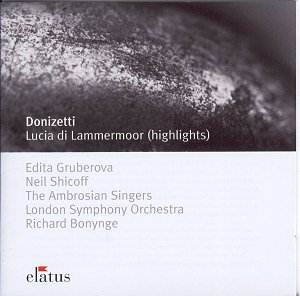The Teldec recording of the complete opera, from which
these highlights are derived, was issued in the U.K. in the autumn
of 1992. It, and the 1990 recording featuring Cheryl Studer and
Domingo (DG) which followed a few months later, vied for market
share with Joan Sutherland's 1961 and 1971 recordings (Decca) and
Callas's two from the 1950s. Whilst both Studer's Lucia and Domingo's
Edgardo have greater tonal variety and colour than their counterparts
on this issue, Gruberova's girlish Lucia, with pinpoint coloratura,
appealed to many, as did Bonynge's more stylish conducting. The
complete recording, like these highlights, was obviously conceived
and structured to fit Gruberova's Lucia. A singer of manifest gifts,
particularly in the lyric coloratura bel canto repertoire, it is
to be regretted that the 'major' recording companies should have
so sadly neglected her. It has been her 'own' Nightingale label
that has provided us with her interpretations of some of the major
roles in this fach. Often linked to theatre performances these issues
have been limited in their appeal by the presence of less than top
quality co-principal singers. Perhaps the international appeal of
Sutherland deterred companies from featuring a singer mainly, but
not wholly, based in Germanic Europe. In many ways Gruberova's voice
and coloratura skills are akin to Beverly Sills; both singers lacking
the depth of tone and palette of colour that Sutherland brings to
the part in both her recordings. However, Gruberova's singing and
interpretation are good and her diction is immeasurably superior.
In the 'mad scene' she follows the flute with fluency (tr.12) and
characterizes well if without the sheer impact and dynamism of Sutherland.
The surrounding 'international' cast all sing adequately if without
particular distinction. Schicoff is brighter in tone and less
inclined to 'can belto' than on some of his recorded interpretations.
His 'Fra poco', and 'Tu che a Dio', from the final scene (trs.15-16)
are well shaped and expressed, if without the tonal beauty that
Pavarotti evinces (Decca, 1971). Agache as the villain brother
has good tone and vocal colour but is a little blustery at times,
whilst the lean bass of Miles, as the two faced Raimondo, is well
tuned and characterised. What the principals lack, and the chorus
too, is Italianate 'squilla'; that particular quality of colour
of voice, allied to turn of phrase, of the native. In this respect,
this recording is only marginally different than both of the Sutherlands
or the DG. This is where the Callas recordings do score with La
Scala forces and Italian co-principals. However, the later, stereo
version is badly let down by the singing of both the diva herself
and Tagliavini as Edgardo. The sound of the earlier mono recording
is not of the best.
A competitive highlights disc from Sutherland's 1971 recording
is available in Decca's mid-price 'Opera Gala' series at nearly
twice the price of this issue. It is good value in that it contains
over half the music that is spread over three (un-competitive)
full priced discs. The only other highlights disc listed is from
the second Callas version. As well as poor singing it has only
sixty minutes of music. If you want the complete opera, the DG
and Sutherland's 1961 recording are now available on two mid-price
discs.
The present recording is in a clear warm acoustic with the orchestra
forward of the singers although Gruberova's Lucia seems more favoured
in this latter respect. Bonynge conducts slightly more spaciously
than he did for his wife in 1971; above all he has a natural feel
for the flow of this music. The leaflet gives an adequate synopsis
of the story, in English, French and German, which would have
been improved by being track related! All things considered, this
is a generous sample of an under-recorded singer performing music
she knows and loves. It can be thoroughly enjoyed.
Robert J Farr

